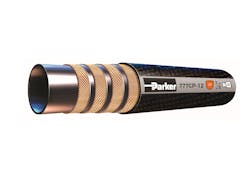Parker Critical Protection Hose Cover Offers Protection from External Damage
The Critical Protection (CP) hose cover from Parker Hannifin is designed to protect hydraulic hoses on mobile equipment operating in harsh environments. It incorporates patent-pending technology which protects against external damage.
Key features of the CP hose cover include:
- abrasion resistance
- allows hoses to retain flexibility
- operating temperature of -40 to 275 F
- MSHA (Mine Safety and Health Administration) approved
READ MORE: Hose Safety and Reliability in Mining
Durability Ensures Hose Performance
Parker developed the CP hose cover after studying why its hydraulic hoses were failing in the field. Falling debris and other external factors were causing hose covers to be removed when used in harsh environments such as forestry and mining. This caused hydraulic hoses to become more susceptible to damage and eventual failure.
As unplanned downtime can be costly in heavy machinery applications, ensuring the durability of components like hoses is critical. Therefore, Parker developed the CP hose cover to prevent damage and reduce downtime as well as maintenance.
The CP hose cover's patent-pending design ensures the cover is not removed should a rock, tree branch or other object fall on the hydraulic hose said Greg Reardon, Business Development Manager at Parker Hannifin, in an interview with Power & Motion. In addition, the cover does not limit the flexibility of the hose so it remains easy to install for OEM customers.
Reardon said often a heavy plastic sleeve is placed on the hose or OEMs create a guarding in their machines to protect hydraulic hoses. However, these options can be expensive and not as effective. The CP hose cover provides an alternative which overcomes these challenges.
In addition, the cover is designed to protect against impacts and abrasion to provide further durability in harsh environments. Tested using ISO 6945 showed results in line with other abrasion-resistant hose designs.
Reardon sees the CP hose cover benefitting a range of heavy equipment. One of the field tests Parker conducted for the hose cover was in an underground mining application which can be a particularly harsh operating environment.
After conducting side-by-side testing of the hose cover and a traditional hydraulic hose, Reardon said it was determined the cover could double the life of the hose in this application. "That's a significant savings for [the customer]," he said.
About the Author
Sara Jensen
Executive Editor, Power & Motion
Sara Jensen is executive editor of Power & Motion, directing expanded coverage into the modern fluid power space, as well as mechatronic and smart technologies. She has over 15 years of publishing experience. Prior to Power & Motion she spent 11 years with a trade publication for engineers of heavy-duty equipment, the last 3 of which were as the editor and brand lead. Over the course of her time in the B2B industry, Sara has gained an extensive knowledge of various heavy-duty equipment industries — including construction, agriculture, mining and on-road trucks —along with the systems and market trends which impact them such as fluid power and electronic motion control technologies.
You can follow Sara and Power & Motion via the following social media handles:
X (formerly Twitter): @TechnlgyEditor and @PowerMotionTech
LinkedIn: @SaraJensen and @Power&Motion
Facebook: @PowerMotionTech

Leaders relevant to this article:


